|
|




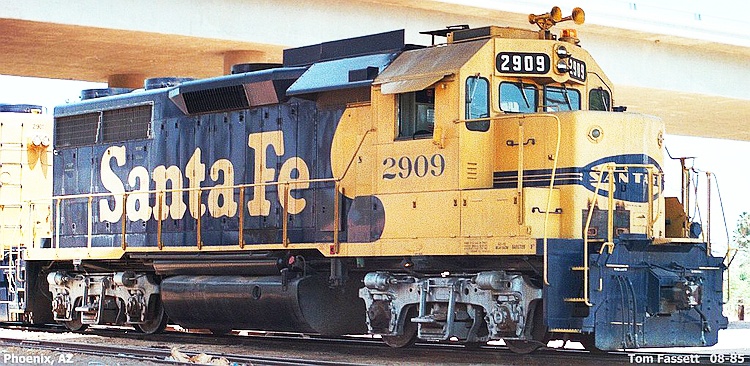

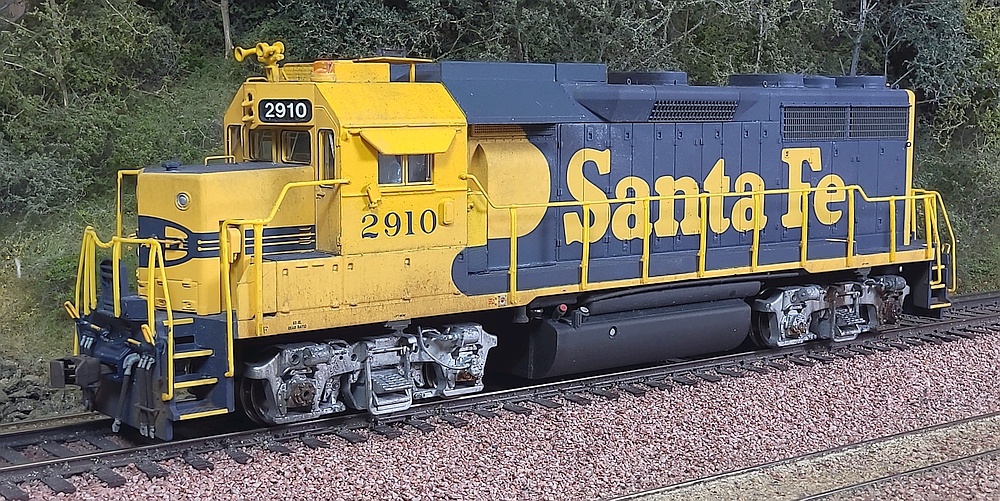


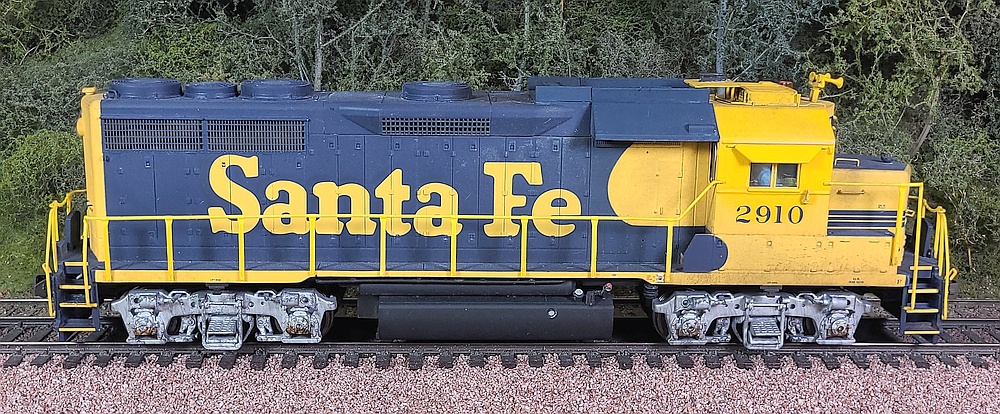

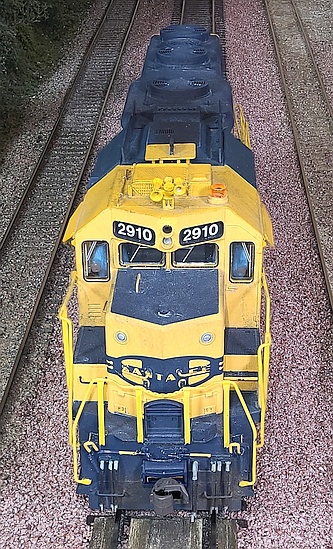
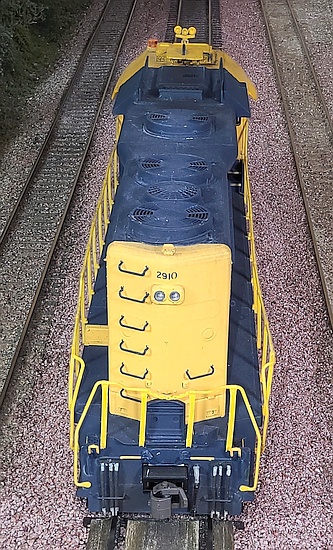
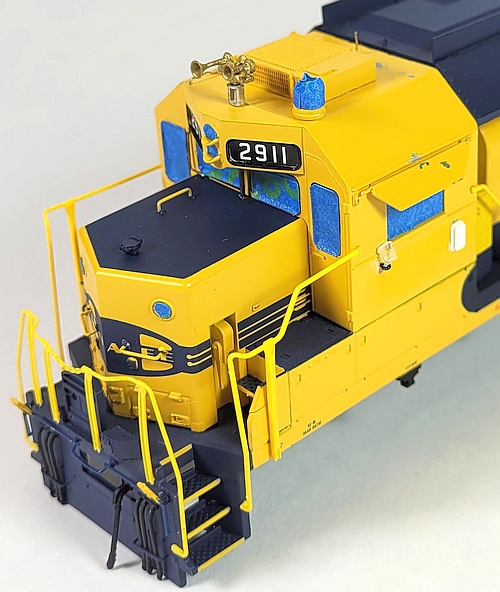
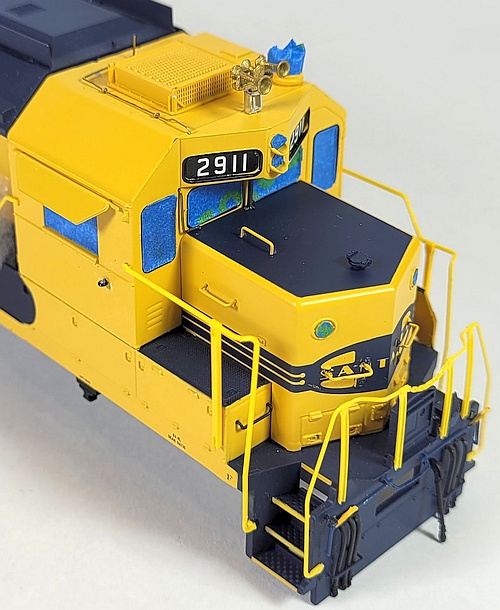
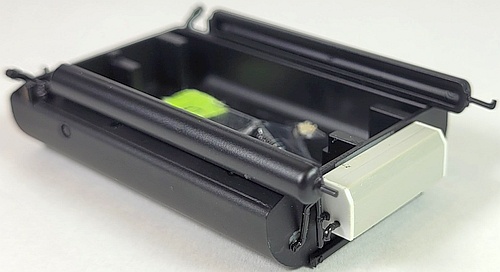







ATSF GP35u 2910
I started with a Walthers Proto model decorated in Santa Fe warbonnet.
To replicate a Santa Fe rebuilt GP35, I added and modified details, and renumbered
the unit to 2910. I also replaced the lights with brighter LEDs and installed DCC with sound.
Weathering is a combination of artist oils and powdered chalks.
I started with a Walthers Proto model decorated in Santa Fe warbonnet.
To replicate a Santa Fe rebuilt GP35, I added and modified details, and renumbered
the unit to 2910. I also replaced the lights with brighter LEDs and installed DCC with sound.
Weathering is a combination of artist oils and powdered chalks.
Right: This photo of the prototype
2909 circa 1985 inspired my
model of sister unit 2910. It shows
most of the important details I
tried to replicate, including the
early-80's era exhaust lifters and
air intake shrouds behind the cab.
These were intended to reduce
diesel exhaust finding its way into
the air intakes. Many GP35u rebuilds got them, as well as a
number of other ATSF locos in the
early 1980's. For whatever reason,
they didn't last long - most had
been removed by 1990.
Unit 2909 also has the fuel cut-off
button integrated into the main
sidesill.
Thanks to Tom Fassett for sharing
this image online.
2909 circa 1985 inspired my
model of sister unit 2910. It shows
most of the important details I
tried to replicate, including the
early-80's era exhaust lifters and
air intake shrouds behind the cab.
These were intended to reduce
diesel exhaust finding its way into
the air intakes. Many GP35u rebuilds got them, as well as a
number of other ATSF locos in the
early 1980's. For whatever reason,
they didn't last long - most had
been removed by 1990.
Unit 2909 also has the fuel cut-off
button integrated into the main
sidesill.
Thanks to Tom Fassett for sharing
this image online.
Below: These photos show some of the added details before I primered and repainted the cab to blend everything together.
I've masked the windows, lights, and beacon to protect them from the painting and weathering processes.
To remove the factory-applied blue cab numbers, I used a new Xacto blade to carefully scrape off the old numbers.
I found that using a chemical to dissolve them off (e.g., Solvaset) just made a smeary mess that was difficult to
over-paint with yellow, which tends to be translucent and requires many coats to cover anything but primer white or gray.
I've masked the windows, lights, and beacon to protect them from the painting and weathering processes.
To remove the factory-applied blue cab numbers, I used a new Xacto blade to carefully scrape off the old numbers.
I found that using a chemical to dissolve them off (e.g., Solvaset) just made a smeary mess that was difficult to
over-paint with yellow, which tends to be translucent and requires many coats to cover anything but primer white or gray.
The WalthersProto model came equipped with exhaust lifters and air intake shrouds behind the cab.
I scratch-built the radio platform (behind the A/C unit) from styrene. Note the brass-wire conduit for the radio.
Other parts I added are cab-side mirrors, a new Cal Scale airhorn, the A/C drainpipe on the cab front,
The pipe under the number boards feeding the airhorn, fuel pressure gauges on the fuel tank.
Per Santa Fe practice, the outside brake shoes and brackets have been removed.
I scratch-built the radio platform (behind the A/C unit) from styrene. Note the brass-wire conduit for the radio.
Other parts I added are cab-side mirrors, a new Cal Scale airhorn, the A/C drainpipe on the cab front,
The pipe under the number boards feeding the airhorn, fuel pressure gauges on the fuel tank.
Per Santa Fe practice, the outside brake shoes and brackets have been removed.
Right: The space between the rear truck and fuel tank seemed
"empty", until I realized ATSF added a retention tank there
during rebuild. As an experiment, I modeled this using rectangular
styrene tubing beveled along one edge, and styrene sheet end caps.
I added some piping salvaged from an Athearn fuel tank detailing set.
"empty", until I realized ATSF added a retention tank there
during rebuild. As an experiment, I modeled this using rectangular
styrene tubing beveled along one edge, and styrene sheet end caps.
I added some piping salvaged from an Athearn fuel tank detailing set.
Below: On the drive, I replaced the DC board with a WalthersProto GP35-specific Soundtraxx Tsunami-1
sound decoder obtained through Walthers replacement parts department. I installed a Scale Sound Systems
3D-printed speaker enclosure with speaker, which sounds awesome. I also managed to fit a TCS KA-1
keep-alive on top the decoder. Super-sticky green masking tape holds things in place.
sound decoder obtained through Walthers replacement parts department. I installed a Scale Sound Systems
3D-printed speaker enclosure with speaker, which sounds awesome. I also managed to fit a TCS KA-1
keep-alive on top the decoder. Super-sticky green masking tape holds things in place.
Many ATSF GP35s had the fuel cut-off button located on a bracket hanging below the main sidesill.
But some, like 2909 and my model 2910 here, have the button integrated into the sidesill.
But some, like 2909 and my model 2910 here, have the button integrated into the sidesill.
-- About
-- Contact
-- Diesels
-- Links
entire website copyright Gregg Fuhriman
created with CoffeeCup Visual Site Designer
created with CoffeeCup Visual Site Designer
-- Layouts
-- Modules
-- Signalling









